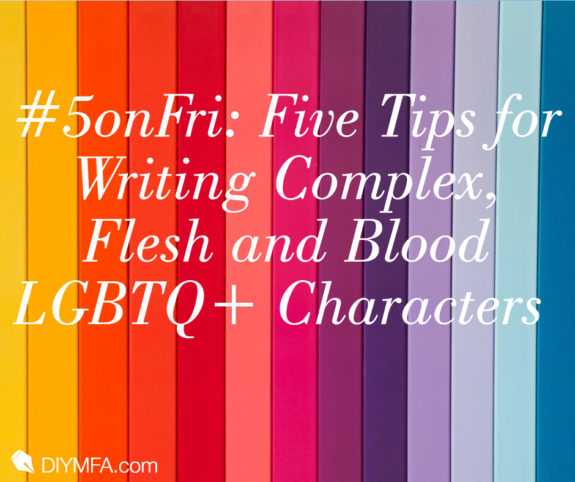Any list of tips for writing complex, flesh and blood LGBTQ+ fictional characters should mirror the list for writing complex, flesh and blood LGBTQ+ human characters. Whether you identify as a member of one of the groups represented by the capital letters+ or not, it takes passion, knowledge, empathy, imagination, skill, and love to write fictional characters into complex, flesh and blood humans.
The above is obvious, but there are huge challenges in writing a character that readers identify with, can’t forget, and miss when they finish reading the piece—whatever their sexuality/identity. So let’s jump in at the deep end:
1) Dig Deeper to Avoid Stereotypes
In writing your characters—whether you belong to the same sexual/gender identity or not—avoid stereotypes, tired devices, conventional narratives. Vast and disparate groups of LGBTQ+ people are corralled into the narrowest of descriptions by the narrowest of minds: sad and despairing, lonely victims; hysterical and giddy; whatever. Similarly unimaginative and ignorant stereotypes are applied to every race, ethnicity, and religion on the planet, too. Reject them all and start fresh.
If you rely upon or even step into these well-worn tropes for an LGBTQ+ character (an editor accidentally added the word limp to the description of my deceased, gay male character’s wrist—I deleted it), you’ll pen a cartoon, stopping at one dimension, and that makes you a poor writer, whatever your own identity. For inspiration and instruction, read literature.
2) Read Literature
Undoubtedly, you already read literature to nurture your fiction writing. For writers of LGBTQ+ characters, reading literature with LGBTQ+ characters and experiences—queer literature—is key. Great writers have written complex gay and lesbian characters in the past, and fresh voices are writing flesh and blood LGBTQ+ characters now.
Here are two links to lists of contemporary works, for readers of different ages, in every genre, from writers of all identities, by authors from all over the world, and every experience and viewpoint:
The Best of Trans Literature by Susan Stryker
The Top 10 Queer Books of 2018 by Them Magazine
Don’t forget to go back in time, too, even if you’ve read these authors before. Explore lesbian and gay themes in the works of: James Baldwin, Rita Mae Brown, Emma Donoghue, E.M. Forster, Patricia Highsmith, Christopher Isherwood, Armistead Maupin, Alice Walker, Sarah Waters, Oscar Wilde, Jeanette Winterson, Virginia Woolf and many more (other than as a curiosity, Radclyffe Hall’s The Well Of Loneliness won’t help):
The Best 25 LGBT Novels of All Time — The Advocate
3) Gain Inspiration Without Breaking A Sweat
Contemporary movies and TV series are stepping up to the plate (finally), such as Orange Is The New Black, in which a trans woman actor plays a trans woman with depth. Google contemporary TV series and movie LGBTQ+ characters worth viewing, in the eyes of critics and community members. Don’t stop at TV series and movies, because no matter how well written and portrayed, you must add more to your arsenal as a writer—read good fiction.
4) Consider Your Limitations
If you’ve only met trans people casually or not at all, then it’s doubtful you’ve gained enough knowledge about the trans experience to write a flesh and blood character. In that case, you should not tackle a major trans character, or even a secondary trans character. Write what you know—get the knowledge, or change course on the character’s identity to include what you want to write.
5) Write It
What about crisscrossing sexual and gender identities between writer and fictional character? Should a woman writer attempt a gay male character? Hanya Yanagihara wrote her best-selling novel, A Little Life, centered on four gay men. Should a male writer create lesbian characters? Should men write women protagonists, as they have with self-annointed authority since time immemorial? Michael Cunningham wrote about lesbians in The Hours, and Colm Tóibín, a gay man, created heterosexual women protagonists in Brooklyn and Nora Webster. All of these novels are about much more than their characters’ genders and sexual identities, so does it matter that the authors don’t share the identities of their characters? Overwhelmingly, critics and readers alike applaud the novels listed above—and while reactions are more mixed among community members, they are widely read, their characters enjoyed.
Still, there’s good reason to read Virginia Woolf’s Orlando—her own identity fantasy portrayed in her own wonderful writing—at least in addition to Michael Cunningham’s version of her life. The same can be said for reading gay male authors writing about gay men, women about women, trans authors writing trans characters—but all fiction falls into some degree of verisimilitude—it’s up to the reader to decide the level of success the author has achieved.
The late Toni Morrison’s novel Paradise did not spell out for the reader which characters were white and which were black. She wanted “to dissuade people from reading literature in that way. Race is the least reliable information you can have about someone. It’s real information, but it tells you next to nothing.”
Is the same true for sexual and gender identities? It’s real information about a person and it is defining—if only in the way the world reacts to the person’s identity—but it never captures the sum total of anyone’s parts, it never speaks for the whole of the person.
Writing is above all about taking chances. Whether or not you share the same sexuality or gender identity as your character, go for it. If you think you have the passion, skill, knowledge, empathy, imagination, and love to pull off a complex, flesh and blood character, one who makes all readers feel the living being in the fiction, whatever the character’s sexuality/gender identity or yours—write it—write the character and find out.
To quote the late, great Toni Morrison again, “If there is a book that you want to read, but it hasn’t been written yet, you must be the one to write it.”

Constance Emmett’s debut historical/LGQ novel, Heroine Of Her Own Life, published by Next Chapter, begins shipping from Amazon at the end of August. She writes in an aerie-like office in the beautiful foothills of the Massachusetts Berkshires, where she lives with her wife and their dog. Her non-fiction is posted on her blog, or connect with her on Twitter, Facebook, or Instagram.







